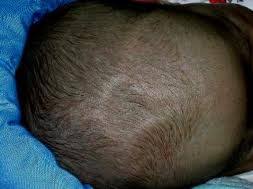NTIWA ISI/ NKUWA ISI/OKA ORI – THE SOFT SPOT IN A BABY’S HEAD
NTIWA ISI/ NKUWA ISI – Igbo
OKA ORI – Yoruba
FONTANELLES: English
What we call it may differ depending on your tribe or dialect. It is that stuff that most mothers see often in the front of their babies head as if the skull is open or separated.
– It is known to be of concern to many mothers or caregivers and they often apply substances ranging from clay, herbs, thread, oils etc with a bid to fasten its closing up.
What is NTIWA ISI? it is the soft spot in a newborn/ baby’s head. An area on the frontal part of the head and also the back part that have no bones leaving the two halves of the skull bone held by a membrane and the skin.

IMPORTANCE/SIGNIFICANCE OF THE SOFT SPOT
– It helps for ease of passage of the head through the birth canal. The skull bones of the baby with the soft spots are able to overlap on each other without damage to the soft brain as the head passes through the birth canal.
– the soft spot also allows for adequate brain expansion and development and for adequate increase in head size as the baby grows.
Therefore the soft spot being present in a newborn is not an illness. Some conditions like prematurity,dehydration[lack of fluid in the body especially from diarrhoea] and malnutrition may make the soft spot more obvious and depressed.
So the facts are
– a baby born without a soft spot needs to see a paediatrician
– the soft spot in front (anterior fontanelle ) closes within 9-18 months of age and 3-6 months for the back ones (posterior fontanelle)
– the soft spot remaining open beyond the ages above , see a paediatrician
– the muds and herbs pasted on these spots have no known proven medical value
– the soft spot can be used by your babies doctor to figure out some abnormalities
– do you have any concern about your child’s soft spot talk to your paediatrician.
– A baby has 6 soft spots
– Boys soft spots tend to close faster than that of girls.
4 Possible Problems associated with Ntiwa isi:
1) Anterior fontanel is too big (~4 cm): Down syndrome, hypothyroidism or increased pressure in the brain are possible causes
2) Early closure: This is often normal as it can close as early as 1 month but we must watch the overall growth of the head and the symmetry to be sure that the brain is growing underneath.
3) Bulging: Indicates that there is increased pressure in the skull. Infection would be a common cause (including meningitis or encephalitis). Another cause is something called hydrocephalus where the fluid that sits inside the brain and spinal cord is accumulating and increasing pressure.
4) Sunken: This is usually dehydration. Particularly if the baby is not feeding well, is having vomiting or diarrhea or has any other reason they might be dehydrated. A slightly sunken fontanel in an otherwise normal acting and appearing baby may be normal.
Friends have you being told that your child have NTIWA ISI/NKUWA ISI before your start any self unorthodox or even orthodox intervention, kindly see your certified paediatrician.
Culled from Paediatricians Give Answers and Dr Justin Smith .























